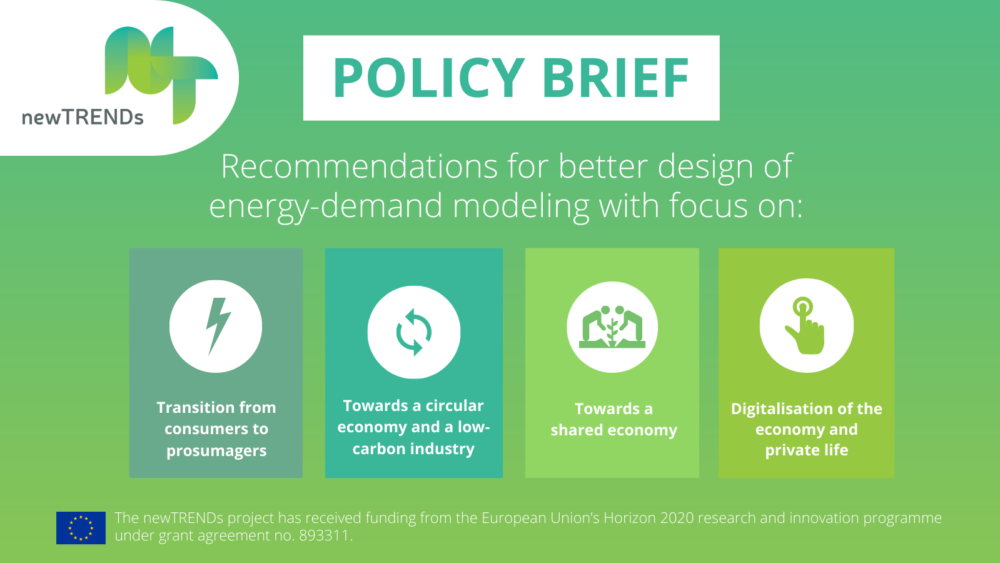The newTRENDs project seeks to recognize and model the influence of New Societal Trends on energy demand, and hence develop scenarios of their future development. Emerging New Societal Trends will certainly have a significant impact on how we live, move, produce, work, and therefore use energy. Considering the current environmental crises, it must be ensured that these trends do not have negative consequences for the environment, and on the contrary, lead to reduced energy consumption of energy and raw material. To reach this goal, this report provides policy-driven and policy makers’ needs driven recommendations for energy demand-side models, with particular focus on FLEX (prosumagers and big data related to the built environment), PRIMES-TREMOVE (transport including shared economy solutions for mobility), FORECAST-Industry (modeling circular economy for the deep decarbonization of industry) and FORECAST-Tertiary (digitalization in the services sector).
The most important recommendations for the implementation of specific policies in energy demand modeling for energy demand-side models are:
- Modeling of energy communities should consider additional distinction for collective self-consumption and energy consumption, not only in a single household but in multiple houses working in an energy community for various tariff and tax designs, which could improve energy prices input;
- Modeling of material flows in the construction sector should consider Green Public Procurement (GPP) criteria for circularity in the building sector in a holistic manner, addressing both the overall impact of a building and the environmental characteristics of its individual components;
- Modeling of shared economy in transport should consider adjusting the influence and importance of the different aspects when opting for a shared mobility option, as it was shown that preferences and the traditional model of private mobility are less important than mobility habits and spatial niches for site-based policy measures. It should also explore the possibilities of enabling car sharing in less urbanized areas with prioritization for convenience;
- Modeling of data centers should consider the exploitation of excess heat for district heating in a particular location together with water resources and air humidity. Even though they are not directly connected with the energy use in the data center, they can affect the cost of cooling system operation;
- All models should consider climate risks, as in Europe we can already observe extreme climatic events and rising temperatures. These events can have a major impact on energy demand and specific aspects also mentioned in the investigated cases on energy communities, circular economy, shared economy in mobility, as well as data centers. For example, the efficiency of photovoltaics for prosumers, air conditioning demand in buildings and for energy communities, additional private transport use in periods of high temperatures/climate extremes, and additional energy needed to run data centers.
We should bear in mind that despite the great effort already put into regulating and accelerating the transformation in the four analyzed areas, there are still substantial gaps to be addressed, which may significantly contribute to further acceleration of the green and digital transition. If the trends are accompanied by the right policies, they could also be a cost-effective way to reduce energy demand by enabling businesses and individuals to participate in creating smart grids, decreasing emissions from daily transportation in the cities, greening the investments through public procurement or minimizing the carbon footprint of data centers. Nevertheless, the regulations introduced may also have some negative impact on vulnerable social groups that should also be considered. Energy demand models can help work out the limits for the regulations and help project possible outcomes.



Comments are closed.